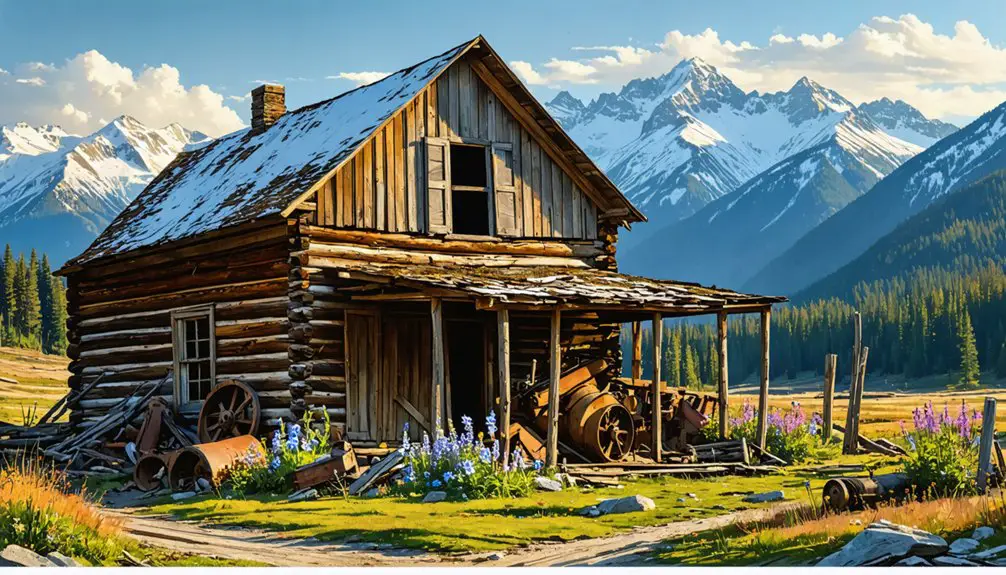You’ll find Hecla’s carefully preserved ruins at 9,000 feet in Montana’s Pioneer Mountains, where an innovative silver mining community once housed 1,800 residents. Under Henry Knippenberg’s meticulous direction, this 19th-century settlement distinguished itself with advanced infrastructure, including a 200-student school, church, and sophisticated tramway system. Though the silver panic of 1893 eventually led to its decline, Hecla’s engineering achievements and social planning principles continue to intrigue modern explorers.
Key Takeaways
- Hecla was a meticulously planned mining community near Lion Mountain, Montana, housing up to 1,800 residents during its peak operations.
- The town featured essential infrastructure including a church, 200-student schoolhouse, and the Hecla Mercantile & Banking Company.
- Mining operations produced 13.38 million ounces of silver between 1873-1965 before declining ore quality led to eventual abandonment.
- The silver panic of 1893 severely impacted operations, leading to mine closures and final shutdown by 1904.
- Today, scattered remnants of Hecla’s mining community can be found throughout Montana’s Pioneer Mountains, challenged by harsh alpine conditions.
The Rise of a Montana Mining Empire
While many mining operations dotted Montana’s landscape in the late 19th century, the Hecla Mining Company emerged as a particularly influential enterprise following James Toner’s initial claim of the Hecla mine in 1885.
Under the guidance of visionaries like John A. Finch and Amasa B. Campbell, you’ll find that Hecla Mining quickly established itself through economic diversification and strategic infrastructure development. The company’s initial capitalization of $500,000 upon incorporation in 1891 set a strong foundation for its future growth.
The company’s presence transformed the region around Lion Mountain, where several mining towns sprouted, including Glendale, Bryant, Trapper City, and Lion City. The company’s recent acquisition of Rock Creek in Montana promises to deliver substantial silver and copper resources for years to come.
Henry Knippenberg’s leadership proved vital as he oversaw the construction of Hecla itself in 1881. The installation of a four-mile narrow-gauge tramway connecting the mine to the mill demonstrated the company’s commitment to operational efficiency and technological advancement.
Life in Hecla’s Heyday
Imagine yourself walking through Hecla’s carefully organized streets, where up to 1,800 residents lived in a community complete with fire protection and waterworks systems.
You’d find miners heading to work the silver-rich tunnels while merchants like H.W. Kappes operated the town’s mercantile stores, providing essential goods to the bustling population. Many residents enjoyed refreshments at the Montana Brewery, which helped establish Hecla as the most civilized town in the district.
Your children would have attended the one-room schoolhouse alongside 200 other pupils under teachers like Blanche Lamont, while the local church served as a cornerstone of the community’s social life. Today, Hecla exists as one of many place name references that share this historic title.
Community Planning and Design
After relocating in 1881 under Henry Knippenberg’s direction, Hecla emerged as a meticulously planned mining community situated one mile from Lion City. The town’s spatial organization prioritized efficient mining operations while fostering community engagement through strategically placed facilities.
You’ll find evidence of thoughtful infrastructure in the extensive water works system that served both domestic and industrial needs for up to 1,800 residents. The town’s success was reflected in its post office establishment in 1881. The Glendale smelter expanded operations after rail connections arrived that same year.
The layout integrated essential services, including a one-room schoolhouse accommodating 200 pupils, a Methodist church for social gatherings, and a narrow-gauge tramway extending four miles to the mill.
Housing clusters were positioned near mining operations for worker convenience, while the fire protection system safeguarded the mainly wooden structures.
The hilltop cemetery‘s location reflected careful consideration of cultural and practical needs.
Daily Work and Commerce
During Hecla’s prime operating years, the bustling mining district hummed with diverse industrial activities centered around silver, lead, copper, and zinc extraction. Like the Montana Vigilantes who restored order in other mining towns, local authorities maintained a relatively peaceful community.
You’d find complex labor dynamics at play, with specialized miners working alongside Canadian and French woodcutters who supplied the essential 100,000 bushels of charcoal needed monthly for smelting operations. In 1875, the district saw major growth when 40-ton smelter was constructed by Noah Armstrong and Charles Dahler.
The commerce evolution reflected a sophisticated economic ecosystem. You could purchase supplies at the Hecla Mercantile & Banking Company, while nearby Glendale offered amenities like the Montana Brewery, hotels, and restaurants.
A narrow-gauge tramway transported ore four miles to the mill, where a 20-stamp facility processed the valuable minerals. This integrated system of trade and industry yielded over 656,000 tons of ore, generating revenues exceeding $19 million throughout its operational lifetime.
Education and Social Activities
While Hecla’s mining operations drove its economic engine, the town’s social fabric was woven through its educational and communal institutions.
You’d find education dynamics centered around a one-room schoolhouse that served roughly 200 pupils, with notable teachers like Blanche Lamont guiding the town’s youth through basic multi-grade instruction.
The town’s social cohesion emerged through various gathering spaces. You could attend services at the local church, which doubled as a community meeting hall, or join neighbors at the mercantile company store for casual socializing. During its peak years, the town supported a thriving population of three thousand residents.
Hecla’s deliberate design as a more civilized settlement than nearby camps fostered family-oriented activities like church socials, school events, and holiday celebrations. The water works system and fire protection further reflected the community’s commitment to creating a stable, structured environment.
Engineering Marvels of Mountain Mining
As you examine Hecla’s engineering feats, you’ll find an intricate narrow-gauge mountain tramway system that revolutionized ore transport across challenging terrain.
Similar to the 4,900-foot deep shafts used at Calumet and Hecla in Michigan, Hecla’s mining operations pushed the boundaries of underground engineering capabilities.
The site’s innovative network of charcoal kilns produced up to 100,000 bushels monthly, supplying essential fuel for the mining operation’s extensive smelting needs.
These advanced smelting operations incorporated blast furnaces and processing facilities that handled 40 tons of lead ore daily, marking significant technological progress in Montana’s mining history.
Narrow Gauge Mountain Tramway
The remarkable Narrow Gauge Mountain Tramway of Hecla stands as one of Montana’s most innovative 19th-century mining engineering achievements. Under Henry Knippenberg’s direction after 1881, this four-mile transport system connected the mountainous mine to the Glendale mill, revolutionizing ore movement through the rugged Pioneer Mountains.
The tramway construction tackled formidable engineering challenges, incorporating specialized design elements to navigate steep terrain and harsh weather conditions.
You’ll find that the narrow-gauge track system allowed for tighter curves and lighter materials, while carefully engineered supports withstood severe seasonal changes. The system’s efficiency transformed Hecla’s operations, reducing reliance on horse-drawn wagons and supporting the town’s growth to 2,000 residents.
Though few remnants survive today, this engineering marvel exemplifies the ingenuity that drove America’s western mining expansion.
Innovative Charcoal Kiln Network
Standing among Montana’s most remarkable industrial engineering feats, Hecla’s innovative charcoal kiln network revolutionized mining operations through its sophisticated fuel production system.
You’ll find 23 beehive-shaped brick domes, each standing 20 feet tall and spanning 25 feet in diameter, designed for maximum charcoal efficiency. These engineering marvels produced an astounding 1.2 million bushels of charcoal in 1895 alone, fueling the smelting of 40,000 tons of ore.
The kiln engineering showcased remarkable temperature control through precise airflow management. Skilled operators monitored smoke color and density to perfect the carbonization process, while strategically placed air vents allowed meticulous regulation of internal temperatures.
This network, requiring 27,000 cords of wood annually, powered Glendale’s silver and lead smelter, ultimately contributing to over $20 million in precious metal extraction.
Advanced Smelting Operations System
Beyond the charcoal kilns‘ remarkable fuel production lay Hecla’s groundbreaking smelting operation system, which represented a pinnacle of 19th-century metallurgical engineering.
You’ll find sophisticated roasting furnaces paired with multi-chamber reverberatory designs that maximized heat distribution and metal recovery. The smelting technology incorporated water-powered blowers and mechanized ore crushing systems, while proprietary extraction methods tackled complex sulfide ores through gravity separation and flotation techniques.
The ore processing infrastructure featured concrete smelter buildings, extensive rail networks, and protective snow sheds that guaranteed year-round operation.
You can trace how the facility’s innovative ventilation shafts, dust collection systems, and tailings management protocols set new standards for industrial safety. This all-encompassing system enabled the efficient recovery of silver, lead, zinc, and copper, adapting continuously to fluctuating production demands.
The Silver Boom Years
During Hecla’s most prosperous era, the mining district yielded an impressive 13.38 million ounces of silver between 1873 and 1965, alongside substantial deposits of gold, copper, lead, and zinc valued at over $19.6 million.
You’ll find that silver mining operations thrived during the late 19th century when industrial demand and metal prices peaked. The district’s economic fluctuations became evident as operations expanded to include both open-pit and underground mining, supported by extensive infrastructure including a 20-stamp mill at Lion City.
The boom created a diverse workforce, with Canadian and French woodcutters supplying timber while Italian workers managed charcoal production, consuming up to 100,000 bushels monthly for smelting.
However, the devastating silver panic of 1893 triggered a sharp decline, leading to widespread mine closures and the final shutdown of Hecla’s operations by 1904.
Daily Operations and Innovation
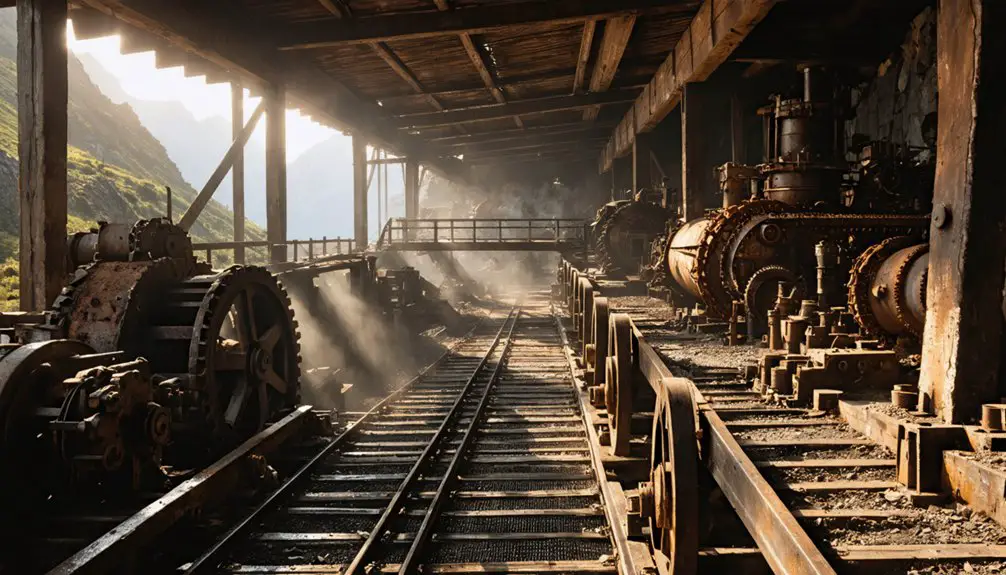
You’ll find Hecla’s operational excellence showcased in its four-mile narrow-gauge tramway system, which efficiently connected the town to its processing facilities.
The mining company’s technological infrastructure included a sophisticated 40-ton smelter that achieved remarkable production levels of nearly one million ounces of silver annually by 1875.
Your understanding of Hecla’s innovation wouldn’t be complete without noting the company’s adaptability, as demonstrated by their continued processing of old slag piles until 1922, long after initial ore deposits were depleted.
Mining Technology Advancements
While Hecla’s mining operations initially relied on conventional methods, the company’s commitment to technological innovation revolutionized underground mining practices throughout Montana.
You’ll find evidence of this technological evolution in their pioneering use of paste fill, a sustainable mining technique that mixed tailings with binders to reinforce mined-out areas. They also introduced battery-powered equipment that dramatically reduced emissions and ventilation costs underground.
Perhaps most prominently, Hecla adapted the Swedish “upside-down mining” technique, first implementing it at the Star mine in 1980. This method, along with underhand longwall mining beneath engineered backfill, considerably improved worker safety.
The construction of their concrete-lined Silver Shaft in 1984 further demonstrated their dedication to advanced infrastructure and efficient resource extraction.
Transportation Systems Evolution
As Hecla’s mining operations expanded, the installation of a four-mile narrow-gauge tramway transformed the settlement’s transportation capabilities.
You’ll find this innovation dramatically improved ore movement efficiency, replacing the previous transportation challenges of difficult wagon routes to Melrose.
The arrival of the Utah Northern Railroad in 1881 further revolutionized trucking logistics, connecting Hecla’s mines to broader markets through Melrose’s critical rail junction.
You’ll appreciate how this extensive transportation network, including municipal infrastructure and improved roads, supported nearly 2,000 residents during peak operations.
The tramway’s integration with rail systems created a sophisticated daily workflow, balancing ore transport with civilian needs.
This transportation evolution proved essential for Hecla’s dominance over nearby Lion City as the district’s primary settlement.
Charcoal Production Excellence
Between 1881 and 1900, Hecla’s charcoal production reached unprecedented levels through an impressive network of 23 beehive-shaped kilns that fueled the region’s essential smelting operations.
You’ll find that each massive kiln, standing 20 feet tall and 25 feet wide, exemplified charcoal efficiency through precise design and operation protocols.
The process demanded exceptional labor specialization, with Canadian and French woodcutters harvesting the lodgepole pine, while Italian experts managed the intricate burning process.
Each 15-day production cycle required meticulous attention: workers loaded 35-45 cords of wood, monitored smoke color, and adjusted vents to control carbonization.
This sophisticated operation yielded up to 1.2 million bushels annually, supplying the Glendale smelter‘s voracious appetite for high-quality charcoal needed to process 40,000 tons of silver and lead ore.
Community Development and Social Order
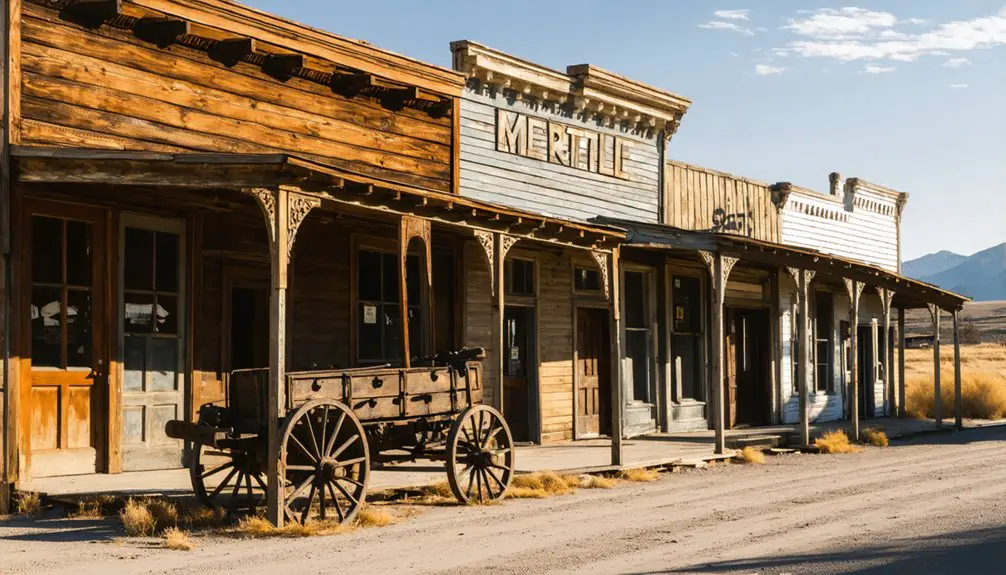
Under the strategic direction of Henry Knippenberg, manager of the Hecla Consolidated Mining Company, Hecla emerged as a meticulously planned community designed to foster social order and industrial efficiency.
Located a mile from the rowdier Lion City, Hecla’s development reflected deliberate company oversight aimed at creating a stable, family-oriented environment.
By distancing itself from nearby chaos, Hecla cultivated an orderly community where families could thrive under watchful corporate guidance.
You’ll find evidence of community cohesion in the town’s carefully planned infrastructure, including a church, a 200-student school, and modern amenities like fire protection systems and waterworks.
The Hecla Mercantile & Banking Company centralized economic activity, while boarding houses provided controlled living spaces for miners.
With a peak population of 1,500-1,800 residents, the town successfully balanced industrial productivity with social stability, distinguishing itself from the temporary nature of earlier mining settlements in the region.
Economic Forces and Market Changes
While Hecla’s social foundation remained strong through careful community planning, the town’s economic stability faced mounting challenges in the late 19th century. The devastating silver market collapse of 1893, triggered by the Sherman Silver Purchase Act’s repeal, marked the beginning of severe economic fluctuations.
Though the district’s mining sustainability benefited from diversified mineral production including lead, copper, and zinc, the downturn proved difficult to overcome. You’ll find that the Hecla Consolidated Mining Company attempted to maintain stability through its controlled economy, establishing the Hecla Mercantile & Banking Company and investing in infrastructure.
Supporting industries like charcoal production, which supplied the Glendale smelters with up to 100,000 bushels monthly, helped sustain the economy temporarily, but couldn’t prevent the eventual decline as high-grade ore deposits depleted.
The Final Days of Production
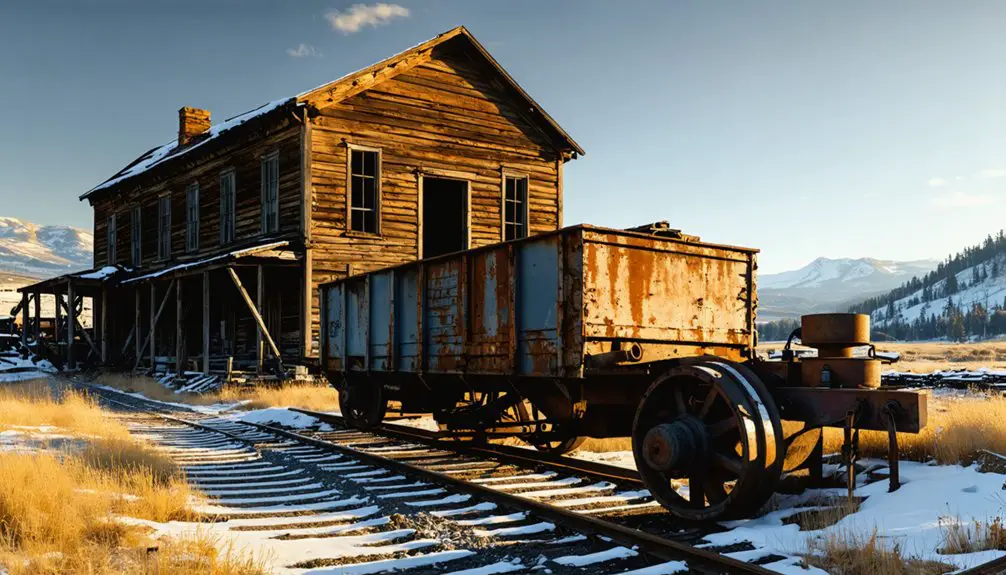
Despite significant investments in infrastructure and processing capabilities, Hecla’s mining operations entered their terminal phase as high-grade ore deposits steadily declined through the 1890s.
You’ll find that final operations focused primarily on extracting value from lower-grade ores and mill tailings, with the main mine reaching its ultimate depth of 3,600 feet by 1944.
The production decline led to several attempts at revival, including the construction of a 20-stamp mill near Lion City in the 1910s.
Your understanding of Hecla’s last chapter should note that heap-leaching continued until 1992, when the mine poured its final ounce of gold.
While technical improvements like concrete structures and enhanced concentrators tried to maximize efficiency, the reality of depleted resources and market pressures ultimately sealed Hecla’s fate.
Preserved Remnants and Historic Sites
Although time has eroded much of Hecla’s physical presence, you’ll find scattered remnants of this once-thriving mining community throughout Montana’s Pioneer Mountains. A handful of ruined buildings, deteriorating mining structures, and remnants of the town’s social infrastructure await your ghost town exploration at elevations approaching 9,500 feet.
Significant preservation challenges stem from the harsh alpine climate and limited accessibility, with the site only reachable during a brief three to four-month window each year.
You’ll need a high-clearance vehicle or ATV to navigate the rugged Trapper Creek Road. While exploring, you can trace the extensive network of mine tunnels, including the historic Cleopatra mine, and discover surviving structures in the neighboring settlements of Glendale and Lion City within the broader mining district.
Legacy of the Lion Mountain District
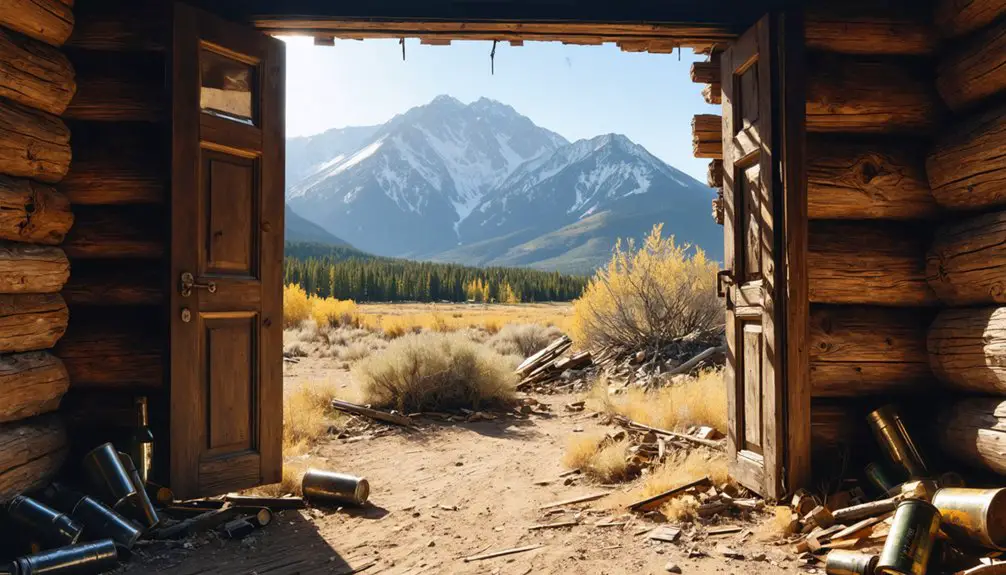
The Lion Mountain Mining District stands as one of Montana’s most significant historical mining regions, with its four interconnected towns generating an impressive $20-22 million in precious metals during its operational lifetime.
This rich mining heritage yielded over 13.4 million ounces of silver, 18,250 ounces of gold, and massive quantities of lead, copper, and zinc from 656,078 tons of ore.
The district’s economic legacies extend beyond its mineral wealth. You’ll find evidence of innovative infrastructure, including a sophisticated 20-mile tunnel network and a 38-kiln charcoal plant that once consumed 100,000 bushels monthly.
Though the 1893 Sherman Silver Purchase Act‘s repeal ultimately led to the district’s decline, the area’s remarkable achievements in engineering, community development, and mineral extraction continue to influence Montana’s mining narrative.
Frequently Asked Questions
Were There Any Major Mining Accidents or Disasters in Hecla’s History?
You’ll find one major historical accident in Hecla’s mining safety record: a 1919 hoisting disaster killed four miners and injured three when a confused engineer’s signals caused a cage malfunction.
What Happened to the Residents After Hecla Was Abandoned?
You’ll find that Hecla residents dispersed to nearby mining communities like Lion City, Glendale, and Greenwood after 1904, while others left Montana entirely. Hecla’s legacy continued through these relocated families.
Did Any Famous Outlaws or Gunfighters Ever Visit Hecla?
You won’t find any outlaw legends or gunfighter tales directly tied to Hecla. While nearby towns like Bannack and Virginia City attracted notorious figures, Hecla’s controlled company-town environment deterred such visitors.
What Was the Average Miner’s Wage in Hecla During Peak Operations?
While you’d expect detailed records from such a significant operation, wage comparisons show miners likely earned $2-3 per day under tough mining conditions, matching regional standards of early 1900s western mines.
Were There Any Native American Conflicts During Hecla’s Active Mining Years?
While specific Native American Relations at Hecla aren’t well-documented, you’ll find that Mining Tensions followed regional patterns of conflict over sacred lands, resources, and territorial rights during the late 1800s mining boom.
References
- https://en.wikipedia.org/wiki/Hecla
- https://westernmininghistory.com/towns/montana/hecla/
- https://www.mtghosttowns.com/glendale
- https://montanahistoriclandscape.com/tag/hecla-smelter/
- https://www.legendsofamerica.com/mt-hecla/
- https://www.encyclopedia.com/books/politics-and-business-magazines/hecla-mining-company
- https://cdapress.com/news/2016/feb/14/hecla-mining-125-years-old-and-not-slowing-5/
- https://archiveswest.orbiscascade.org/ark:80444/xv261608
- https://southwestmt.com/ghosts/ghost-towns/glendale-and-canyon-creek-charcoal-kilns/
- https://www.islands.com/1911056/montana-garnet-day-mining-town-best-preserved-abandoned-mountains/
